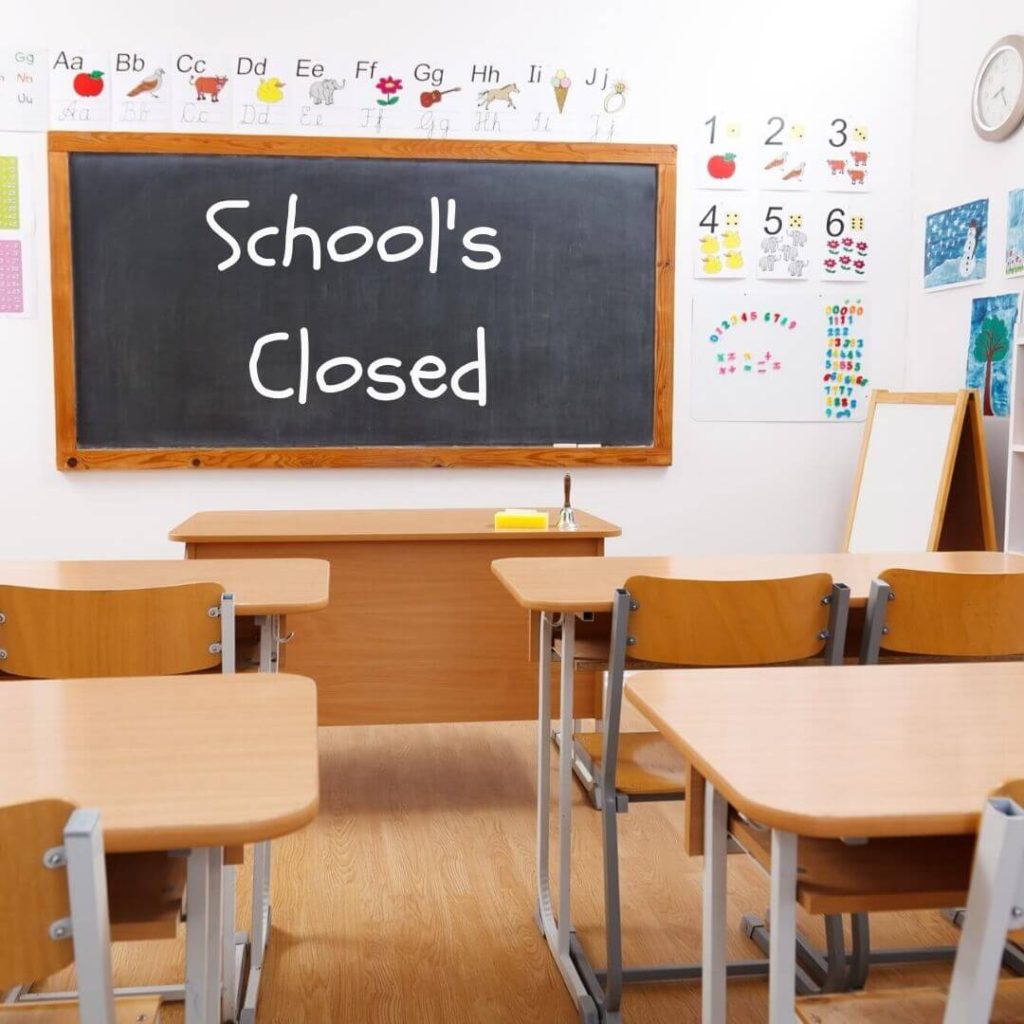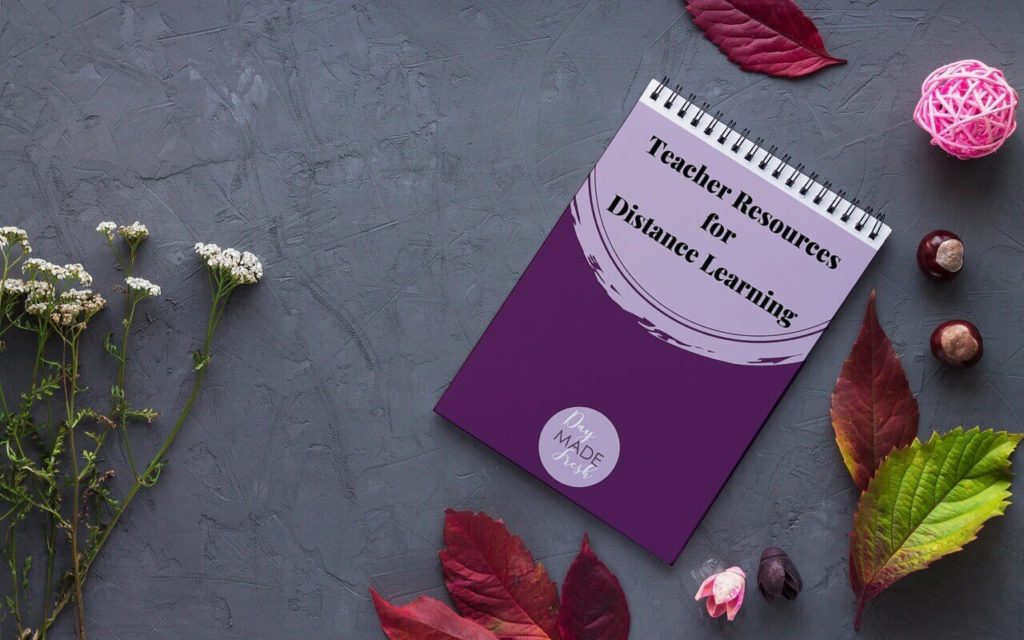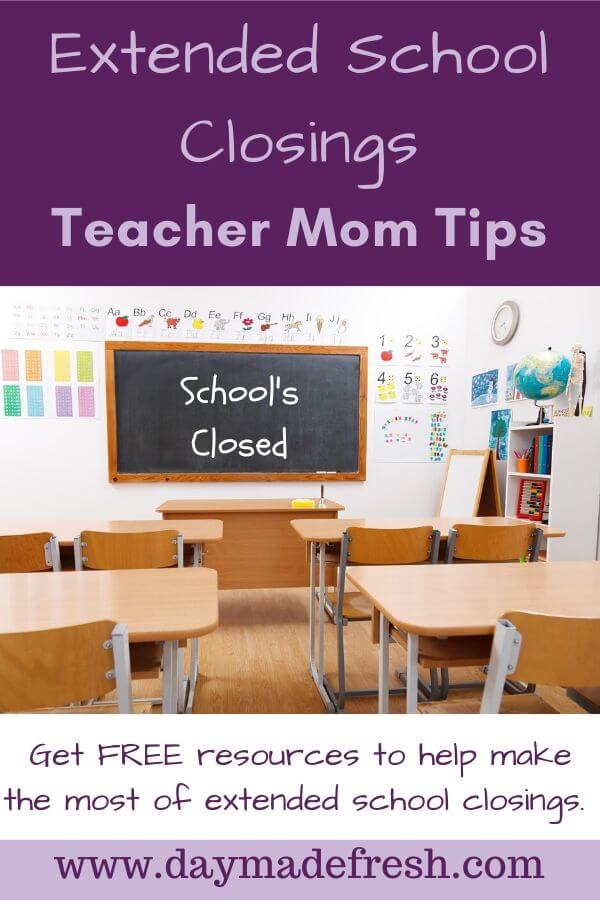In the last few years, we’ve experienced some extended school closings. One year freezing temperatures and large amounts of snow kept us out of school for weeks. As I write this we are out of school for four maybe more weeks because of the novel coronavirus or Covid-19.
There is often excitement at the idea of time off of school. However, it can also bring feelings of uncertainty. As teachers, we worry about losing momentum with students. It can also be mentally draining being stuck in the house.
As teacher moms, we have to balance our own family’s needs with those of our students and their families. When it comes to extended school closures each school district handles it differently. Some teachers are expected to teach remotely online. Others are told to send work, but none of it can be required. Some teachers are even expected to be at school working in their classrooms. This can be difficult if we have to care for our own children as well.
As teachers, we can make the most of an extended school closure.

It can be overwhelming trying to balance it all. So how can we start to regain a sense of normalcy? I’ve found planning things out can help me gain a sense of normalcy.
Create A Plan
In the past, when school was canceled I spent my time doing whatever I wanted whenever I wanted. Now, that I’m a mom I’ve found we do better with a schedule. My how times have changed.
To manage to work with your students from home and take care of your own children it will be helpful to create a schedule of your own. Your schedule will depend on the age of your own children.
It’s important to protect your sanity. If you overstretch yourself you won’t be at your best which will impact your ability to help those that rely on you. Set aside time blocks for different tasks you need to complete. Such as contacting families, video conferences, grading student work or teaching your own children. This will help you protect time with your family and time for self-care.
Looking for resources to help you meet students’ and their families’ needs? Click here to get a set of resources that you can customize using google forms or slides.

There are many pre-paid schedules out there for families to use. Ultimately we need to find what works for our family. The same is true for our students’ families. Instead of creating a detailed schedule give them a few set blocks of time they should include in their schedule. Here’s an example:
- Reading Language Arts (20-30 minutes)
- Math (20-30 minutes)
- Science/ Social Studies/ STEM (15-30 minutes)
A schedule like this gives families the freedom to make it work for their unique family schedule. Like you, parents could be trying to fit helping their child with school work around working from home.
Check-In with Families
Instead of trying to guess what families need during an extended school closing, you can ask them. An easy way to do this is to survey your families. This is a quick way to make a connection with your students’ families and make sure you’re using your time wisely.
Need help creating a family needs check-in survey? Click here and get a FREE google form that you can edit to fit your needs. PLUS other resources.
You have enough on your plate. Don’t spend hours creating online activities for your students if they’re not going to use it. Make the best use of your time and your students’ by figuring out what they actually need from you.
I also caution you to only offer what you’re able to do. As you know, as a mom as well as a teacher, you’re going to have to focus on your own children. It can be easy to get caught up in making creative lesson plans, worksheets, and scheduling daily video conferences with students. Unless teaching students through remote teaching or elearning is required by your district, don’t overwhelm yourself.
At-Home Learning Plans
To kids, a snow day or day off of school means free time and NO school. This means it can be hard to get students on board with learning at home during extended school closings. Especially if the work isn’t required and isn’t going to be graded.
So how do we get students on board? First, we need to keep expectations low. If one student completes an assignment we made an impact. To get students engaged with learning at home keep activities familiar and enticing.
Want FREE editable documents to help you create your At-Home Learning Plan? Click here to get your copy.
Make things easier for families by giving them activities students have done before. Using familiar systems limits confusion and allows students to focus on learning. If you do need to introduce a new program make your directions clear to help students begin using it effectively. The goal is to limit the amount of time you have to spend troubleshooting issues with families.

When students are at home there are a lot of distractions that are a lot more enticing than schoolwork. This makes our task a little more difficult, but it can also allow us to use our creativity.
You know your students best and what types of activities will grab their attention. My students this year lo ve the idea of creating their own “book.” So for their narrative writing assignment, I created a google slide template that helps them make their story into a picture book.
Ideas to help engage student interest:
- Include Student Choice: Allow students a chance to learn about topics that interest them.
- Offer Rewards for Completed Assignments: This can help get reluctant learners on board. Rewards could include physical rewards, online game time, etc.
- Help Students “Get Out” to the Outside World: If students are stuck inside because of weather or social distancing cabin fever can set it. We can help counteract this by sharing online field trips or similar resources.
- Locate Online Resources: There are great online resources that can help you engage your students. Suggested resources: Google Education Suite (Google Classroom), Seesaw, ClassDojo, Zoom, etc.
In the end, remember to keep your expectations low. Many families won’t or can’t make learning happen at home. Keep in mind what you would like your child’s teacher to do to support your family. Ultimately, if you engage a few students in getting on board with at home or online learning you’ve succeeded.
Get Back On Track
If you’re out of school for multiple weeks it can feel overwhelming trying to figure out how to get back on track. If you have to make up days missed at the end of the school year this is no problem. But, if the days are forgiven and you don’t need to make them up you’ll have to reconfigure what you’re going to teach.
There are a few options when trying to figure out what you will teach for the remainder of the year. I would first suggest seeing if you can still fit everything in. If you’re out for a week or two this may be possible. If the extended school closure is over two weeks this is most likely not reasonable. If you try to cram everything in you will stress yourself and your students out.
Instead of trying to cover everything in a shortened time you will have to choose which topics to cover. For each subject, and which you’ll need to decide which topics you will have to skip. When choosing what topics to teach I would suggest looking at state or standardized tests. It is also helpful to see what skills are needed in the next grade level.
If I have to choose between a data collection and graphs unit versus a multiplication unit in third grade. I would focus on the multiplication unit because it is a foundational skill. It is also necessary for student success in fourth grade. It can be beneficial to work closely with the grades below and above you as you create your new plan.
Another way to try and condense topics and skills is to find ways to integrate subjects. This is a great strategy anytime. It’s especially helpful when you’re low on instructional time. One way to do this is to teach science or social studies during reading. Teaching these subjects using informational texts is a great use of your time. You can often integrate science and math skills together. An example of this is working on data collection during science. Another way to save time is to connect writing assignments to what students are currently learning.
It’s important to not try and get everything in and that can be hard for some of us that like to check off all the boxes. It was hard for me the first year I didn’t get to everything. But, I found that I was able to be more creative with how I taught subjects. I also discovered great ways to integrate subjects that I could use in the proceeding years.
As teachers, we have the power to make the most of an extended school closure. When stuck at home because of the weather or social distancing we can bring a sense of normalcy to our students. We can also use our creativity in how we teach and engage our students during this time.
We may look back at times of extended school closings as stressful and overwhelming. Yet, our goal should be that kids don’t remember this time in the same way. Instead, we should try and help them remember this time in a positive way. Help them make it a great story they tell to their kids. About how they got to learn at home, video conferenced with their teacher and classmates, or that they discovered how important school is.
Related post: Working from Home with a Toddler as a Teacher
What do you do to help your students during an extended school closing? What have you found helpful in balancing your own family and your students? Comment below what has worked for you or let me know how I can better help you.
Don’t forget to get a FREE set of Teacher Resources to help you make the most of distance learning during extended school closings. Click HERE now.
